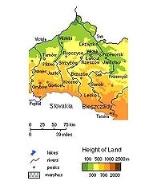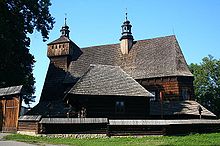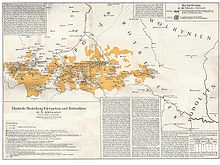
Walddeutsche
Encyclopedia
Walddeutsche Germans
' onMouseout='HidePop("17266")' href="/topics/Wood">wood
), sometimes simply called Polish Germans, the name for a group of people, mostly of German origin, who settled during the 14th-17th century on the territory of present-day Sanockie Pits, Poland, a region which was previously only sparsely inhabited because the land was difficult to farm.

, 1531, Szymon Starowolski
1632, bp. Ignacy Krasicki
and Wincenty Pol
, and is also sometimes used to refer to Germans between Wisłoka and San River
part of West Carpathians Plateau and Central Beskidian Piedmont in Poland.
(Poland), the oldest wooden Gothic temples in Europe, erected in the 14th century, on the UNESCO
list of World Heritage Sites since 2003.
Germans settled in the territory of the Kingdom of Poland
(territory of present day Subcarpathian Voivodeship
) from the 14th to 16th centuries (see Ostsiedlung
), mostly after the region returned to Polish sphere of influence in 1340, when Casimir III of Poland
took the Czerwień
towns.
Marcin Bielski
states that Bolesław I Chrobry had settled some Germans in the region to defend the borders against Hungary and Kievan Rus', who later turned to farming. Maciej Stryjkowski
mentions German peasants near Przeworsk
, Przemyśl
, Sanok
, and Jarosław, describing them as good farmers.
Some Germans were attracted by kings seeking specialists in various trades, such as craftsmen and miners. They usually settled in newer market and mining settlements. The main settlement areas were in the vicinity of Krosno
and some language islands in the Pits and the Rzeszów
regions. The settlers in the Pits region were known as Uplander Sachsen . Until approximately the 15th century, the ruling classes of most cities in present day Beskidian Piedmont consisted almost exclusively of Germans.

 The Beskidian Germans underwent Polonization
The Beskidian Germans underwent Polonization
in the latter half of the 17th and the beginning of the 18th century.
According to Wacław Maciejowski, writing in 1858, the people did not understand German but called themselves Głuchoniemcy. Wincenty Pol
wrote in 1869 that their attire was similar to that of the Hungarian and Transylvanian Germans and that their main occupation was farming and weaving. He stated that in some areas, the people were of Swedish origin, however, they all spoke flawlessly in a Lesser Poland
dialect of Polish. In 1885 Józef Szujski
wrote that the Gluchoniemcy spoke only Polish, but there were traces of a variety of original languages which showed that, when they came, the term Niemiec was applied to "everyone". In the modern Polish language, Niemiec refers to Germans, however, in earlier centuries, it was sometimes also used in reference to Hungarians, possibly due to similarity with the word niemy or plural niemi for "mute" or "dumb", additionaly nie my mean the foreign folks.
, Brzostek, Biecz
, Gorlice
, Ropczyce
, Wielopole Skrzyńskie
, Frysztak
, Jasło, Krosno
, Czudec
, Rzeszów
, Łańcut, Tyczyn
, Brzozów
, Jaćmierz
, Rymanów
, Ropczyce
, Przeworsk
, Jarosław, Kańczuga
, Przemyśl
, Dynów
, Brzozów
, and Sanok
.
Germans
The Germans are a Germanic ethnic group native to Central Europe. The English term Germans has referred to the German-speaking population of the Holy Roman Empire since the Late Middle Ages....
' onMouseout='HidePop("17266")' href="/topics/Wood">wood
Wood
Wood is a hard, fibrous tissue found in many trees. It has been used for hundreds of thousands of years for both fuel and as a construction material. It is an organic material, a natural composite of cellulose fibers embedded in a matrix of lignin which resists compression...
), sometimes simply called Polish Germans, the name for a group of people, mostly of German origin, who settled during the 14th-17th century on the territory of present-day Sanockie Pits, Poland, a region which was previously only sparsely inhabited because the land was difficult to farm.

Nomenclature
The term Walddeutsche was coined by the Polish historians Marcin BielskiMarcin Bielski
Marcin Bielski was a Polish chronicler and satirical poet. He was born of noble parentage on the patrimonial estate of Biała, Pajęczno County , in the Polish province of Sieradz. The name Wolski is derived from his estate at Wola...
, 1531, Szymon Starowolski
Szymon Starowolski
Szymon Starowolski was a writer, scholar and historian in the Polish-Lithuanian Commonwealth. He was probably born near Pruzhany, and died near Kraków. He was very prolific writer, left behind over 70 works, mostly in Latin...
1632, bp. Ignacy Krasicki
Ignacy Krasicki
Ignacy Krasicki , from 1766 Prince-Bishop of Warmia and from 1795 Archbishop of Gniezno , was Poland's leading Enlightenment poet , a critic of the clergy, Poland's La Fontaine, author of the first Polish novel, playwright, journalist, encyclopedist, and translator from French and...
and Wincenty Pol
Wincenty Pol
Wincenty Pol was a Polish poet and geographer.-Life:Pol was born in Lublin , to Franz Pohl , a German in the Austrian service, and his wife Eleonora Longchamps de Berier, from a French family living in Poland. Pol fought in the Polish army in the November 1830 Uprising and participated in the 1848...
, and is also sometimes used to refer to Germans between Wisłoka and San River
San River
The San is a river in southeastern Poland and western Ukraine, a tributary of the Vistula River, with a length of 433 km and a basin area of 16,861 km2...
part of West Carpathians Plateau and Central Beskidian Piedmont in Poland.
History
In the 14th century a German settlement called Hanshof existed in the area. Church under call of Assumption of Holy Mary and St. Michael's Archangel in HaczówHaczów
Haczów is a village in Brzozów County, Subcarpathian Voivodeship, in south-eastern Poland. It is the seat of the gmina called Gmina Haczów. It lies approximately west of Brzozów and south of the regional capital Rzeszów...
(Poland), the oldest wooden Gothic temples in Europe, erected in the 14th century, on the UNESCO
UNESCO
The United Nations Educational, Scientific and Cultural Organization is a specialized agency of the United Nations...
list of World Heritage Sites since 2003.
Germans settled in the territory of the Kingdom of Poland
Kingdom of Poland (1385–1569)
The Kingdom of Poland of the Jagiellons was the Polish state created by the accession of Jogaila , Grand Duke of Lithuania, to the Polish throne in 1386. The Union of Krewo or Krėva Act, united Poland and Lithuania under the rule of a single monarch...
(territory of present day Subcarpathian Voivodeship
Subcarpathian Voivodeship
Podkarpackie Voivodeship , or Subcarpathian Voivodeship, is a voivodeship, or province, in extreme-southeastern Poland. Its administrative capital and largest city is Rzeszów...
) from the 14th to 16th centuries (see Ostsiedlung
History of German settlement in Eastern Europe
The presence of German-speaking populations in Central and Eastern Europe is rooted in centuries of history, with the settling in northeastern Europe of Germanic peoples predating even the founding of the Roman Empire...
), mostly after the region returned to Polish sphere of influence in 1340, when Casimir III of Poland
Casimir III of Poland
Casimir III the Great , last King of Poland from the Piast dynasty , was the son of King Władysław I the Elbow-high and Hedwig of Kalisz.-Biography:...
took the Czerwień
Red Ruthenia
Red Ruthenia is the name used since medieval times to refer to the area known as Eastern Galicia prior to World War I; first mentioned in Polish historic chronicles in the 1321, as Ruthenia Rubra or Ruthenian Voivodeship .Ethnographers explain that the term was applied from the...
towns.
Marcin Bielski
Marcin Bielski
Marcin Bielski was a Polish chronicler and satirical poet. He was born of noble parentage on the patrimonial estate of Biała, Pajęczno County , in the Polish province of Sieradz. The name Wolski is derived from his estate at Wola...
states that Bolesław I Chrobry had settled some Germans in the region to defend the borders against Hungary and Kievan Rus', who later turned to farming. Maciej Stryjkowski
Maciej Stryjkowski
Maciej Stryjkowski was a Polish-Lithuanian historian, writer and a poet, notable as the author of Chronicle of Poland, Lithuania, Samogitia and all of Ruthenia , amongst other aspects of this work considered the first printed book on the history of Lithuania.-Biography:Maciej Stryjkowski was...
mentions German peasants near Przeworsk
Przeworsk
Przeworsk Ukrainian: Переворськ, is a town in south-eastern Poland with 15,675 inhabitants, as of 2 June 2009. Since 1999 it has been in the Subcarpathian Voivodeship, and is the capital of Przeworsk County....
, Przemyśl
Przemysl
Przemyśl is a city in south-eastern Poland with 66,756 inhabitants, as of June 2009. In 1999, it became part of the Podkarpackie Voivodeship; it was previously the capital of Przemyśl Voivodeship....
, Sanok
Sanok
Sanok is a town in south-eastern Poland with 39,110 inhabitants, as of 2 June 2009. It's the capital of Sanok County in the Subcarpathian Voivodeship. Previously, it was in the Krosno Voivodeship and in the Ruthenian Voivodeship , which was part of the Lesser Poland province...
, and Jarosław, describing them as good farmers.
Some Germans were attracted by kings seeking specialists in various trades, such as craftsmen and miners. They usually settled in newer market and mining settlements. The main settlement areas were in the vicinity of Krosno
Krosno
Krosno is a town and county in Subcarpathian Voivodeship, Poland with 47,455 inhabitants, as of 2 June 2009.Notably Krosno is the site of the first oil well in the world....
and some language islands in the Pits and the Rzeszów
Rzeszów
Rzeszów is a city in southeastern Poland with a population of 179,455 in 2010. It is located on both sides of the Wisłok River, in the heartland of the Sandomierska Valley...
regions. The settlers in the Pits region were known as Uplander Sachsen . Until approximately the 15th century, the ruling classes of most cities in present day Beskidian Piedmont consisted almost exclusively of Germans.


Polonization
Polonization was the acquisition or imposition of elements of Polish culture, in particular, Polish language, as experienced in some historic periods by non-Polish populations of territories controlled or substantially influenced by Poland...
in the latter half of the 17th and the beginning of the 18th century.
According to Wacław Maciejowski, writing in 1858, the people did not understand German but called themselves Głuchoniemcy. Wincenty Pol
Wincenty Pol
Wincenty Pol was a Polish poet and geographer.-Life:Pol was born in Lublin , to Franz Pohl , a German in the Austrian service, and his wife Eleonora Longchamps de Berier, from a French family living in Poland. Pol fought in the Polish army in the November 1830 Uprising and participated in the 1848...
wrote in 1869 that their attire was similar to that of the Hungarian and Transylvanian Germans and that their main occupation was farming and weaving. He stated that in some areas, the people were of Swedish origin, however, they all spoke flawlessly in a Lesser Poland
Lesser Poland
Lesser Poland is one of the historical regions of Poland, with its capital in the city of Kraków. It forms the southeastern corner of the country, and should not be confused with the modern Lesser Poland Voivodeship, which covers only a small, southern part of Lesser Poland...
dialect of Polish. In 1885 Józef Szujski
Józef Szujski
Józef Szujski was a Polish politician, historian, poet and professor of the Jagiellonian University....
wrote that the Gluchoniemcy spoke only Polish, but there were traces of a variety of original languages which showed that, when they came, the term Niemiec was applied to "everyone". In the modern Polish language, Niemiec refers to Germans, however, in earlier centuries, it was sometimes also used in reference to Hungarians, possibly due to similarity with the word niemy or plural niemi for "mute" or "dumb", additionaly nie my mean the foreign folks.
Settlement
Important cities of this region include PilznoPilzno
Pilzno is a town in Poland, in Subcarpathian Voivodeship, in Dębica County. It has 4,484 inhabitants . It is located at the junction of important roads - West-East European E40 Highway, and National Road 73 Pilzno is a town in Poland, in Subcarpathian Voivodeship, in Dębica County. It has...
, Brzostek, Biecz
Biecz
Biecz is a town and municipality in southeastern Poland, in Lesser Poland Voivodeship, Gorlice County. It is in the Carpathian Mountains, in the Doły Jasielsko Sanockie, by the Ropa River...
, Gorlice
Gorlice
Gorlice is a city and an urban municipality in south eastern Poland with around 29,500 inhabitants . It is situated south east of Kraków and south of Tarnów between Jasło and Nowy Sącz in the Lesser Poland Voivodeship , previously in Nowy Sącz Voivodeship...
, Ropczyce
Ropczyce
Ropczyce is a town in Subcarpathian Voivodeship in south-eastern Poland, situated in the Valley the Wielopolka River and is inhabited by 15,098 people . It is the seat of Ropczyce-Sędziszów County.-Geography:...
, Wielopole Skrzyńskie
Wielopole Skrzynskie
Wielopole Skrzyńskie is a village in Ropczyce-Sędziszów County, Subcarpathian Voivodeship, in south-eastern Poland. It is the seat of the gmina called Gmina Wielopole Skrzyńskie...
, Frysztak
Frysztak
Frysztak is a village in the Gmina Frysztak, Strzyżów County, Subcarpathian Voivodeship, Poland, 17 km from Krosno. Frysztak lies in the historical region often referred to as Galicia. It is located on a hillock near the river Wisłok, on the road from Rzeszów to Krosno...
, Jasło, Krosno
Krosno
Krosno is a town and county in Subcarpathian Voivodeship, Poland with 47,455 inhabitants, as of 2 June 2009.Notably Krosno is the site of the first oil well in the world....
, Czudec
Czudec
Czudec is a village in Strzyżów County, Subcarpathian Voivodeship, in south-eastern Poland. It is the seat of the gmina called Gmina Czudec. It lies approximately north-east of Strzyżów and south-west of the regional capital Rzeszów.The village has a population of 2,900.-References:...
, Rzeszów
Rzeszów
Rzeszów is a city in southeastern Poland with a population of 179,455 in 2010. It is located on both sides of the Wisłok River, in the heartland of the Sandomierska Valley...
, Łańcut, Tyczyn
Tyczyn
Tyczyn is a town in southern Poland with a population of 3,353 inhabitants . It is located in the Subcarpathian Voivodeship , in the Rzeszów County .- History :...
, Brzozów
Brzozów
Brzozów is a town in south-eastern Poland, with 7,677 inhabitants . It is situated in Subcarpathian Voivodeship and is the seat of both Brzozów County and the smaller administrative district of Gmina Brzozów...
, Jaćmierz
Jacmierz
Jaćmierz is a village in the administrative district of Gmina Zarszyn, within Sanok County, Subcarpathian Voivodeship, in south-eastern Poland. It lies approximately north of Zarszyn, north-west of Sanok, and south of the regional capital Rzeszów....
, Rymanów
Rymanów
Rymanów is a town of 3,585 inhabitants . in Poland's Subcarpathian Voivodeship. It is a capital of a separate commune within the powiat of Krosno...
, Ropczyce
Ropczyce
Ropczyce is a town in Subcarpathian Voivodeship in south-eastern Poland, situated in the Valley the Wielopolka River and is inhabited by 15,098 people . It is the seat of Ropczyce-Sędziszów County.-Geography:...
, Przeworsk
Przeworsk
Przeworsk Ukrainian: Переворськ, is a town in south-eastern Poland with 15,675 inhabitants, as of 2 June 2009. Since 1999 it has been in the Subcarpathian Voivodeship, and is the capital of Przeworsk County....
, Jarosław, Kańczuga
Kanczuga
Kańczuga is a town in Przeworsk County, Subcarpathian Voivodeship, Poland, with a population of 3,187 inhabitants . The town was an early centre of the Polish automobile industry. Buses based on Fiat 621R and used in Kraków had bodywork fitted in Kańczuga. Today the town is known for restoration...
, Przemyśl
Przemysl
Przemyśl is a city in south-eastern Poland with 66,756 inhabitants, as of June 2009. In 1999, it became part of the Podkarpackie Voivodeship; it was previously the capital of Przemyśl Voivodeship....
, Dynów
Dynów
Dynów is a town in Rzeszów County, Subcarpathian Voivodeship, Poland, with a population of 6,058 .-Massacre during Second World War:...
, Brzozów
Brzozów
Brzozów is a town in south-eastern Poland, with 7,677 inhabitants . It is situated in Subcarpathian Voivodeship and is the seat of both Brzozów County and the smaller administrative district of Gmina Brzozów...
, and Sanok
Sanok
Sanok is a town in south-eastern Poland with 39,110 inhabitants, as of 2 June 2009. It's the capital of Sanok County in the Subcarpathian Voivodeship. Previously, it was in the Krosno Voivodeship and in the Ruthenian Voivodeship , which was part of the Lesser Poland province...
.

